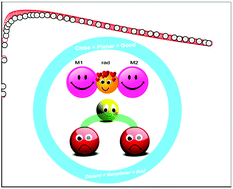当前位置:
X-MOL 学术
›
Dalton Trans.
›
论文详情
Our official English website, www.x-mol.net, welcomes your
feedback! (Note: you will need to create a separate account there.)
Probing the strong magnetic exchange behaviour of transition metal–radical complexes: a DFT case study
Dalton Transactions ( IF 3.5 ) Pub Date : 2020/03/20 , DOI: 10.1039/d0dt00262c Mukesh Kumar Singh 1, 2, 3, 4
Dalton Transactions ( IF 3.5 ) Pub Date : 2020/03/20 , DOI: 10.1039/d0dt00262c Mukesh Kumar Singh 1, 2, 3, 4
Affiliation

|
Attaining very large magnetic exchange coupling values for polymetallic clusters is of great interest in the area of Single-Molecule Magnets (SMMs). Direct contact of paramagnetic centers in metal–radical complexes is known to yield very large magnetic exchange coupling values, but the estimation of such magnetic coupling values for polymetallic metal–radical complexes is not straightforward. Here, five previously reported M2–radical complexes (where M = CrIII, MnII, FeII, and CoII) have been studied using density functional theory. Our calculations suggest that a very strong overlap between the metal 3d orbitals and the radical's singly occupied π* orbital is the foremost reason for reported large magnetic exchange values. Our used methodology also gives a precise estimate of magnetic coupling values for this class of complexes. Model calculations and magneto-structural correlation studies suggest the importance of structural parameters, such as the metal–N(radical) distance and metal–radical planarity, in attaining very higher magnetic exchange coupling values with small structural modification.
中文翻译:

探索过渡金属-自由基配合物的强磁性交换行为:DFT案例研究
在单分子磁体(SMM)领域中,获得多金属簇的非常大的磁交换耦合值非常重要。已知金属-自由基络合物中顺磁性中心的直接接触会产生非常大的磁交换耦合值,但是对多金属金属-自由基络合物的这种磁耦合值的估算并不简单。在这里,五个先前报道的M 2-自由基配合物(其中M = Cr III,Mn II,Fe II和Co II)已使用密度泛函理论进行了研究。我们的计算表明,金属3d轨道与原子团的单占据π*轨道之间非常强烈的重叠是报道的较大磁交换值的最主要原因。我们使用的方法还可以精确估算此类配合物的磁耦合值。模型计算和磁结构相关性研究表明,结构参数(例如,金属-N(径向)距离和金属-径向平面)的重要性对于通过较小的结构修改即可获得更高的磁交换耦合值。
更新日期:2020-04-08
中文翻译:

探索过渡金属-自由基配合物的强磁性交换行为:DFT案例研究
在单分子磁体(SMM)领域中,获得多金属簇的非常大的磁交换耦合值非常重要。已知金属-自由基络合物中顺磁性中心的直接接触会产生非常大的磁交换耦合值,但是对多金属金属-自由基络合物的这种磁耦合值的估算并不简单。在这里,五个先前报道的M 2-自由基配合物(其中M = Cr III,Mn II,Fe II和Co II)已使用密度泛函理论进行了研究。我们的计算表明,金属3d轨道与原子团的单占据π*轨道之间非常强烈的重叠是报道的较大磁交换值的最主要原因。我们使用的方法还可以精确估算此类配合物的磁耦合值。模型计算和磁结构相关性研究表明,结构参数(例如,金属-N(径向)距离和金属-径向平面)的重要性对于通过较小的结构修改即可获得更高的磁交换耦合值。











































 京公网安备 11010802027423号
京公网安备 11010802027423号